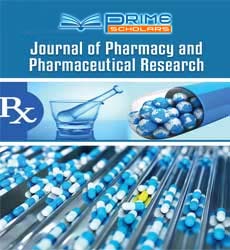Short Communication - (2023) Volume 7, Issue 4
Navigating Infections: The Efficacy of Topical Antibiotic Therapy
Samah Monti*
Department of Pharmacy, Aristotle University of Thessaloniki, Greece
*Correspondence:
Samah Monti,
Department of Pharmacy, Aristotle University of Thessaloniki,
Greece,
Email:
Received: 29-Nov-2023, Manuscript No. IPIPR-24-18832;
Editor assigned: 01-Dec-2023, Pre QC No. IPIPR-24-18832 (PQ);
Reviewed: 15-Dec-2023, QC No. IPIPR-24-18832 ;
Revised: 20-Dec-2023, Manuscript No. IPIPR-24-18832 (R);
Published:
27-Dec-2023, DOI: 10.21767/ipipr.7.04.040
Introduction
In the realm of medical interventions, the application of antibiotics
has long been a cornerstone in the fight against bacterial
infections. While oral and intravenous routes are common, the
use of topical antibiotic therapy has gained prominence, offering
targeted and localized treatment for a variety of skin and soft tissue
infections. This article explores the nuances of topical antibiotic
therapy, examining its advantages, common applications, and
considerations in optimizing its effectiveness. Topical antibiotics
deliver the medication directly to the site of infection, allowing for
focused and targeted treatment. This approach minimizes systemic
exposure, reducing the risk of side effects associated with oral or
intravenous antibiotic administration. By circumventing systemic
circulation, topical antibiotics help mitigate the development
of bacterial resistance. This localized treatment minimizes the
exposure of the entire bacterial population to the antibiotic,
reducing the likelihood of resistance development.
Description
The application of topical antibiotics is often more convenient and
palatable for patients, contributing to increased compliance with
the prescribed treatment regimen. This is particularly beneficial
in managing chronic conditions or for individuals with concerns
about oral antibiotic side effects. Topical antibiotics are frequently
employed for the treatment of common skin infections, including
impetigo, cellulitis, and minor wounds. Creams, ointments, or
gels containing antibiotics such as mupirocin or fusidic acid are
applied directly to the affected area. Topical antibiotics, such as
clindamycin and erythromycin, are integral components of acne
management. They help control the growth of acne-causing
bacteria on the skin’s surface and are often combined with
other topical agents like benzoyl peroxide. Topical antibiotics
play a crucial role in preventing and treating infections in burn
wounds. Silver sulfadiazine and mafenide acetate are commonly
used in topical formulations to promote healing and reduce the
risk of bacterial colonization. Choosing the right antibiotic for a
specific infection is paramount. Factors such as the spectrum of
activity, bacterial susceptibility, and potential for allergic reactions
must be considered to ensure optimal therapeutic outcomes.
Proper application technique is crucial for the efficacy of topical
antibiotics. Ensuring the affected area is clean and applying the
medication in the prescribed manner helps maximize absorption
and effectiveness.
Regular monitoring for signs of resistance is essential, even
in topical antibiotic therapy. If the infection does not respond
adequately, bacterial cultures may be necessary to guide further
treatment decisions. Patients must adhere to the prescribed
treatment regimen for topical antibiotics to be effective.
Inconsistent application or premature cessation of treatment can
contribute to treatment failure and the development of resistance.
As the field of antibiotic research evolves, the development of
novel formulations and delivery systems for topical antibiotics
continues [1-4].
Conclusion
Nanotechnology, for instance, holds promise in enhancing the
penetration of antibiotics into skin layers, potentially improving
their efficacy in treating deeper infections. Topical antibiotic
therapy has emerged as a valuable and targeted approach in the
management of various infections. Its advantages in localized
treatment, reduced systemic resistance, and enhanced patient
compliance make it a versatile tool in the healthcare arsenal. By
carefully considering the specific infection, choosing appropriate
agents, and ensuring proper application techniques, healthcare
professionals can harness the efficacy of topical antibiotics to
promote healing and combat bacterial challenges in a focused and
efficient manner.
Acknowledgement
The author is grateful to the journal editor and the anonymous
reviewers for their helpful comments and suggestions.
Conflict Of Interest
The author declared no potential conflicts of interest for the
research, authorship, and/or publication of this article.
References
- Gaudias J (2021) Antibiotic prophylaxis in orthopedics-traumatology. Orthop Traumatol Surg Res 107(1S):102751.
[Crossref] [Google Scholar] [PubMed]
- Spellberg B, Lipsky BA (2012) Systemic antibiotic therapy for chronic osteomyelitis in adults. Clin Infect Dis 54(3):393-407.
[Crossref] [Google Scholar] [PubMed]
- Ejeta F (2022) Recent formulation advances and preparation of orally disintegrating tablets. Int J Pharm Compd 26(5):370-377.
[Crossref] [Google Scholar] [PubMed]
- Tangden T (2014) Combination antibiotic therapy for multidrug-resistant gram-negative bacteria. Ups J Med Sci 119(2):149-53.
[Crossref] [Google Scholar] [PubMed]
Citation: Monti S (2023) Navigating Infections: The Efficacy of Topical Antibiotic Therapy. J Pharm Pharm Res. 7:040
Copyright: © 2023 Monti S. This is an open-access article distributed under the terms of the Creative Commons Attribution License, which permits unrestricted use, distribution, and reproduction in any medium, provided the original author and source are credited.

